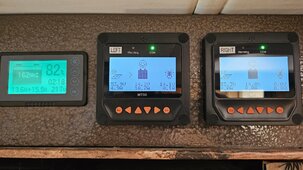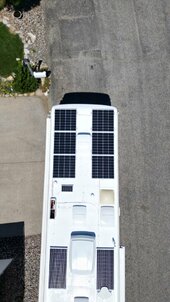MIKEY-W
New Member
Greetings! and thank you for the add!



I have a parallel system. Two identical but separate systems. The power output from the identical charge controllers (EP EVER TRACER AN4210 with MT50 Remote meter) go to the bus bar, then the fuse and on to the battery.
The TRACER charge controllers have the exact same firmware and the settings are set exactly the same.
If you look at the MT50 display for the right controller you will see that it's not putting out any power.
Right display - 85.3 volts from the panels but 0 amps to the controller and then battery.
But the Left display is 53.9 volts from the panels and 4.9 amps to the controller and 18.7 amps to the battery.
This photo was taken when the sun was hitting both arrays of panels at the same angle with no shading.
If I shut off the breaker on the left array of panels, then the right controller will begin production of power again, close to what the left array was producing .
When I turn the breaker for the left array back on, then both controllers will produce comparable power for a short time but then the right controller will go back to zero.
My goal was to have two totally separate systems for redundancy.
Do I need diodes on the output of each controller so they can't backfeed each other? Or should I get a controller with higher capacity and just use one controller?
Thank you all in advance for any help!



I have a parallel system. Two identical but separate systems. The power output from the identical charge controllers (EP EVER TRACER AN4210 with MT50 Remote meter) go to the bus bar, then the fuse and on to the battery.
The TRACER charge controllers have the exact same firmware and the settings are set exactly the same.
If you look at the MT50 display for the right controller you will see that it's not putting out any power.
Right display - 85.3 volts from the panels but 0 amps to the controller and then battery.
But the Left display is 53.9 volts from the panels and 4.9 amps to the controller and 18.7 amps to the battery.
This photo was taken when the sun was hitting both arrays of panels at the same angle with no shading.
If I shut off the breaker on the left array of panels, then the right controller will begin production of power again, close to what the left array was producing .
When I turn the breaker for the left array back on, then both controllers will produce comparable power for a short time but then the right controller will go back to zero.
My goal was to have two totally separate systems for redundancy.
Do I need diodes on the output of each controller so they can't backfeed each other? Or should I get a controller with higher capacity and just use one controller?
Thank you all in advance for any help!


